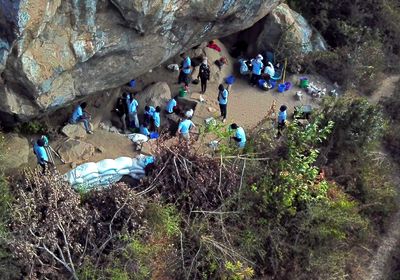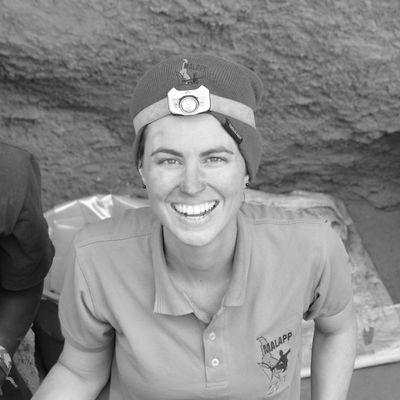ABOVE: Jessica Thompson stands in the middle of the Mazinga 1 site in northern Malawi, directing the research team’s excavation. JACOB DAVIS
The air stank of diesel and dust under the truck, but I was already dirty. Days were spent digging holes, afternoons jerry-rigging field vehicles, and evenings correcting survey data; bucket showers could never quite erase that oily-grainy feeling between my fingers. This is how I spend most of my summers, leading archaeological fieldwork in central Africa.
Two small feet appeared in front of my face. “Mom?” My middle son was standing by the truck. “There’s a bunch of people here to see you. And another person wants you to take them to the doctor.” Once again, it struck me how lucky I was to be here, but how caught I was in the myth of the “ideal worker”: an unattainable ideal of maximal productivity while managing multiple demanding roles.
In the Global North, women in my discipline have gone from almost no professional representation in the 1970s to equal or even greater numbers than men; however, they continue to be rare in top leadership positions, a trend mirrored across the sciences. Although we have little data about how gender intersects with the demands of designing and leading field-based projects, in my experience, the logistics and bureaucracy associated with stepping out of the lab unequally disadvantage female researchers. We have even fewer data about how many people from non-white or other minority groups are leading fieldwork, but the barriers experienced by female academics are compounded for people with these identities.
Certain subsets of academics already perform more service, undertake more emotional labor, and experience consistently higher academic burnout. These extra potholes intersect most acutely in field-based research.
If universities dedicated resources to field project management, as has been implemented successfully by large laboratories for more than 20 years, they could recapture untold amounts of faculty productivity. PIs in the field must be researcher-manager-promoters, a sort of unicorn who can plan and execute the science while also handling an astonishing array of gritty logistical details: recruiting and mentoring student participants, planning travel, stakeholder negotiation, community engagement, compiling media assets, keeping the books (often in multiple currencies), and writing technical reports. These extra drains on time and energy are invisible, unrewarded, and they disproportionately affect researchers who are already drained.
Certain subsets of academics already perform more service, undertake more emotional labor, and experience consistently higher academic burnout. These extra potholes intersect most acutely in field-based research. Women in STEM are fighting to retain their places, as concepts of leadership become problematically bound together with concepts of masculinity and narratives of personal sacrifice as necessary for advancement. In the classroom, students are more likely to perceive female professors as “nurturing,” leading to gendered expectations about caretaking that can compound in the field.
Perhaps the most glaring challenge facing women more so than men is the balancing act of being a parent and doing fieldwork-heavy research. Recently, I spoke to BBC Science in Action about why I believe we are missing many of our female leaders across all field sciences, not just my own. Immediately after airing, a woman who works in polar regions sent me an email. Having children, she said, had “been a huge factor in having to step away from field and research science.”
The timing of the tenure track usually coincides with the period in a woman’s life when she has the highest chances of conception and healthy pregnancy. Layer onto this the unique challenges of doing fieldwork while trying to conceive, being pregnant, or breastfeeding, and the complexity increases exponentially. Once children are born, women take on a disproportionate amount of family management and dependent care. This makes it especially challenging to forge a path to field leadership at the point in their careers when researchers have been shown to be at their most creative.
Over my years doing fieldwork, I have felt conflicted when team members refer to me as the “mother” of my project. Being a mother to three children is a core part of my identity, but motherhood entails duties of care beyond basic logistics. In the field, your team becomes your family. I have held student’s hands at the doctor, fielded their interpersonal concerns, and picked up their dirty dinner plates. On days when my tolerance is thin, I wonder if they would look after themselves more consciously if I was a man. Would they critique or challenge me the same if I was the leader, rather than the mother, of the project?
Being an actual mother also comes with its own costs. I often pay thousands of dollars out of pocket to bring my children to the field. My university offers up to $1,000/year in child care support for professional travel, but this is tiny compared to the actual costs, and is actually generous compared with many other places. Funding agencies such as the National Science Foundation (NSF) should fund dependent travel, and make childcare an allowable research expense. Many field situations are not the nightmare scenarios that keep risk-averse legal teams awake at night; they are safe and authentic opportunities for cross-cultural connection and learning. If taxpayers are concerned that funding travel for other people’s children is wasteful, let me put this into perspective: where I do fieldwork, my living costs are 3 percent of the daily allowable per diem for people staying with US government funding in the same country. The difference between my actual food costs and my allowable meals per diem would be enough to fly two of my children to my field site and back.
Over my years doing fieldwork, I have felt conflicted when team members refer to me as the “mother” of my project. . . . Would they critique or challenge me the same if I was the leader, rather than the mother, of the project?
Fieldwork is not trivial to career-building. A recent study showed that field experience in my discipline is an important component to snagging one of the few available tenure-track jobs, and such roles come with the expectation that fieldwork will continue. Therefore, universities and funding agencies should be at the forefront of strategic advances that make it easier for researchers, especially women and people from minoritized groups, to build and maintain field projects.
Universities must reassess cumbersome regulations that mismatch with the realities of doing work in often-remote locations. They must become less hesitant to fund maintenance of field stations, field vehicles, and field managers, and invest in infrastructure that builds capacity and reduces PI time spent on management. Productivity in academia is measured in grants acquisition, research publications, and citations, prioritizing quick products over long-term project development. This disincentivizes field research, which takes years to grow, and is rife with “non-promotable tasks.” It exacerbates parachute science embedded in colonial practice, because PIs struggle to find the long-term financial and logistical support to build meaningful community and collaborative relationships.
Support for fieldwork is not only an issue of equity, but also productivity. Universities must recognize that every hour spent fiddling with complex logistics is an hour removed from academic duties, and that making up these duties on nights and weekends is not sustainable. In the US, universities charge federal agencies an additional 55 percent, on average, for the indirect costs of on-campus research, and only half of that for off-campus research. But less funding flowing to the university should not be taken as a release of obligation to support the research. In addition to supporting childcare at field sites, indirect costs can be used to hire centralized project managers, a model long implemented by NGOs.
Universities can also promote field leadership by recognizing that field experience is not only important for getting a job, but also for keeping it. They can recalibrate tenure calculations to take into account the up-front investment of building a long-term field project after a person with active field research is hired. This kind of institutional change is not just material; it also signals commitment to the missing social support that plagues the female and underrepresented minority road to leadership in STEM.
Women in STEM and Girls who Code are now household names in the effort to correct obvious imbalances in representation across the sciences. The NSF has made one its four strategic goals for 2022-2026 to grow a diverse STEM workforce, predicting that the number of women in STEM needs to double, and the number of people who identify as Black, Hispanic, and Indigenous more than double, for these fields to be representative of the US population. But universities need to double down on recognizing that these researchers face additional obstacles in certain kinds of science.
There is no problem in choosing a career that keeps you closer to home, or out of the many headaches of leadership roles. But there is a problem if the challenges are so great that the choice is made for you. Early career, female, and minoritized field leaders are forced by the structure of academia into impossible choices about career direction and work-life balance, and untold numbers of exciting field discoveries are not being made as a result. By changing the economics of fieldwork, universities are empowered to diversify STEM leadership while also moving beyond colonial models of field science, enhancing student training, and maximizing faculty productivity.
Now, if you will excuse me, I have to get back to my field accounting.





